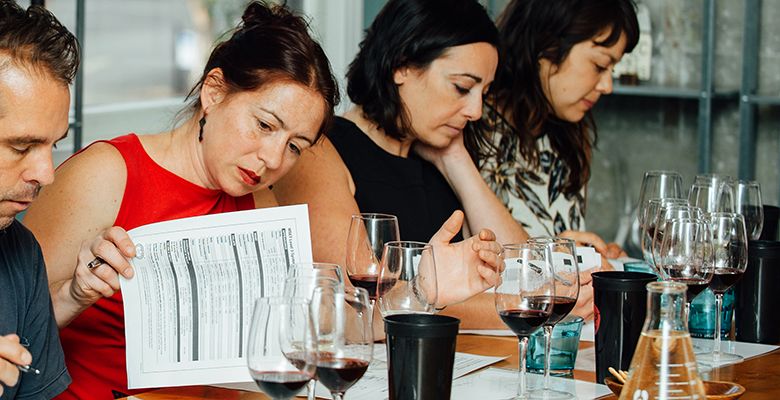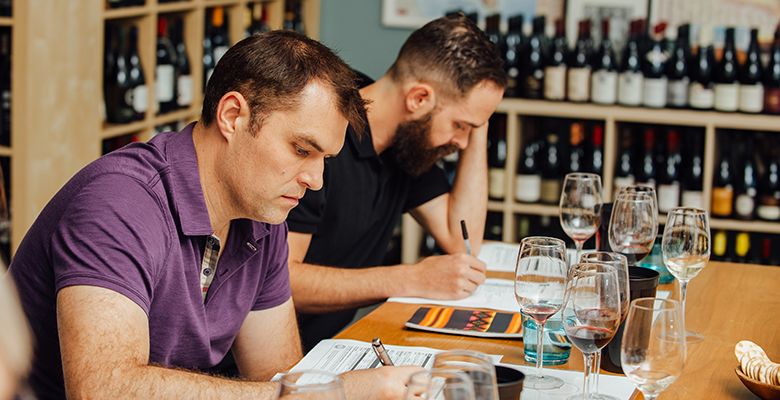Are You Certifiable?
Education a class act at The Wine & Spirit Archive
Story by Jade Helm | Photos by Kathryn Elsesser
Who would devote countless hours, hundreds or thousands of dollars, and maybe a pound of flesh for fancy post-nominals, a few cheaply made lapel pins and some frameable certificates proclaiming your knowledge of wine and spirits?
Well, I did. Now the number of letters behind my name equals the number in it. I never wear those pins. Yet, I would do it again, and I am not alone.
There seems to be an upswing among consumer and industry professionals seeking certification of their wine expertise. If you prefer your nose in a book as often as in the glass, you might consider an academic wine pursuit.
There are numerous certifying agencies: Court of Master Sommeliers, Society of Wine Educators, International Sommelier Guild, plus culinary institutes offering quality wine education. I found the Wine and Spirits Education Trust (WSET) was the best option for me.
W What?
It’s interesting to explain that I am a Diplomat of the Wine and Spirits Education Trust. My words are met with either looks of admiration or blank stares. Fortunately, the former recreation is gaining ground. In Oregon this is due, in part, to Mimi Martin, DWS (Diploma from the Wine and Spirits Educational Trust), educator and owner of The Wine & Spirit Archive (WSA) in Portland.
WSET, founded in the U.K. in 1969, now offers certification courses in 66 countries and 19 languages. Martin brought WSET courses to the Pacific Northwest nine years ago.
“As a student, I thought the WSET program offered an excellent foundation in wine,” Martin says. “As a WSET instructor, I appreciate the organization of the program. Materials are regularly reviewed and updated, exams are fair but challenging, and the WSET is regularly building the reputation of the qualification internationally.”
WSET certifies four levels in the field of wine and spirits. The first three are offered at WSA. Students learn basic concepts of viticulture and vinification, although WSET is not a vineyard management or winemaking program. Students experience grape varietals from different regions and learn factors affecting finished wine — why, for instance, does Cabernet Sauvignon taste different from Bordeaux versus Napa.
At the core of the WSET philosophy is the “systematic approach to tasting.” This sampling regimen gives students a common language to discuss wine professionally. Those pursuing certification in spirits or saké follow a similar study plan.
Seriously, Are You Certifiable?
WSET courses at WSA are a mix of about 60 percent industry, 25 percent consumer and 15 percent planning to change careers. Students with prior wine experience often ask if they should start with Level 2 (Intermediate) or 3 (Advanced).
Martin explains, “Someone who has worked in the Oregon wine business may know this industry well, but may know little about Australia, South Africa, Italy, etc.”
She has a quiz to help students know where to start.
Homework is part of the program, too. This is school, after all. One student shared his surprise at how much could be crammed into a deceptively small textbook. “Each page of each chapter has something important to say, so you better pay attention.”
Studying at home averages 1.5 hours a week for the eight-week Level 2 course and 3 hours a week for the Level 3 course, which lasts 15 weeks. Granted, at least some of the time is required drinking — I mean tasting.
Level 3 students are required to pass a blind tasting. Martin says, “In the weeks approaching the exam, the anxiety is palpable; however, I’ve only ever had one student — out of hundreds — not pass the tasting exam.”
Is It Worth It?
Is WSET worth the time, energy and test-taking apprehension? Students value the program’s reputation, the potential for career advancement and “shared experience” with other wine students around the globe.
Bree Boskov studied WSET in Canada and is now a WSET Certified Educator teaching in Asia, the U.K., and the U.S. Boskov chose the program for “the comprehensive and global wine learning experience.” WSET has provided her an opportunity for global networking and permanent connections. “I have great friendships from my Level 2 and 3 days.”
For Rebekah Bellingham, WSET reinforced her idea that the wine industry was her calling and helped advance her career. “Attending WSET made me realize that the wine industry held everything that I was craving. After graduating from Level 2, I was lucky to find a job at Ribbon Ridge Vineyard, where I could put my education to work.” She returned a few years later to complete Level 3. Bellingham is now a regional sales manager at Elk Cove Vineyards.
As awareness increases in the U.S., so does employer interest. McMenamins recently sent nine of their managers and corporate beverage team members through the WSET Level 2 Course at WSA.
Dan Johnson, owner of Triangle Wine Country and a WSET student at WSA, found the coursework beneficial in a career change from financial advising. He relates a story of a tour guest interested in Montepulciano. “Without hesitation, I was able to explain that the town was located in Southern Tuscany, as well as the differences between Montepulciano d’Abruzzo and Vino Nobile di Montepulciano. That’s when I thought ‘I actually know this stuff.’”
Careful, It’s Addictive
Johnson says it perfectly, “You should expect to be a wine student for the rest of your life. This is not an educational path with a fixed destination but a winding road with ever-changing weather patterns.”
Continued education can be pursued through travel or relaxed consumer classes. The truly certifiable may find themselves on a slippery slope that can turn into a rough climb. In order to earn post-nominals from WSET, one must complete Diploma Level 4. This takes a minimum of two years — some have been working for a decade — and the test is offered in Boston, New York, Philadelphia and Irvine, California. Distance learning options are available, but candidates must test in person.
After earning my Diploma, I rebound my book with binding tape and my spirit with some spirits. According to WSET, “the Diploma is viewed universally as the stepping stone to the Master of Wine qualification.” Hardcore students, like Boskov, pursue that esteemed designation. As for me, I am happy with my level of certification.
I love a classroom regardless of which side of the podium I occupy and am grateful for the opportunity to teach wine students. Teaching, consulting and writing keeps my nose in the books, and the glass, plenty.
How to Choose
If you want to seek certification, there are many programs available. Some focus more on restaurant service. Others are independent study while many offer classes. Consider your goals, time, money and optimal learning style. Research each offering and talk to people who have completed one or more of the programs.
For more information, visit www.wineandspiritsarchive.com and www.wsetglobal.com. I offer feedback on my certifications and can be reached at tastingpour@gmail.com.
Jade Helm is the primary author of Tasting Pour, a blog about wine, cocktails and food. Her expertise is evidenced by credentials from the Society of Wine Educators (Certified Specialist in Wine) and the Wine and Spirits Education Trust (Diploma in Wine and Spirits) and from the Court of Master Sommeliers (Certified Sommelier).















